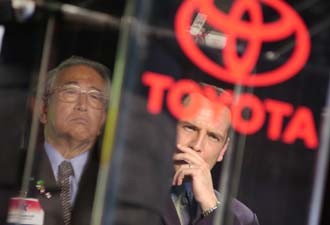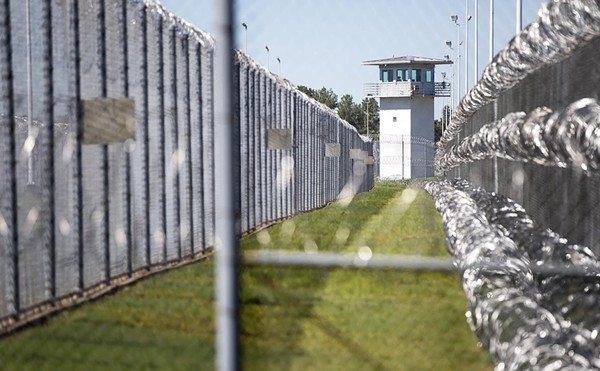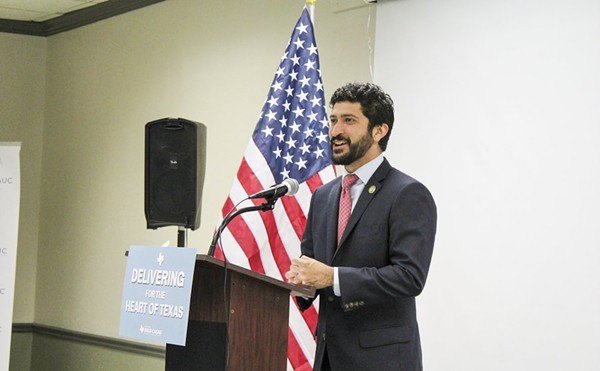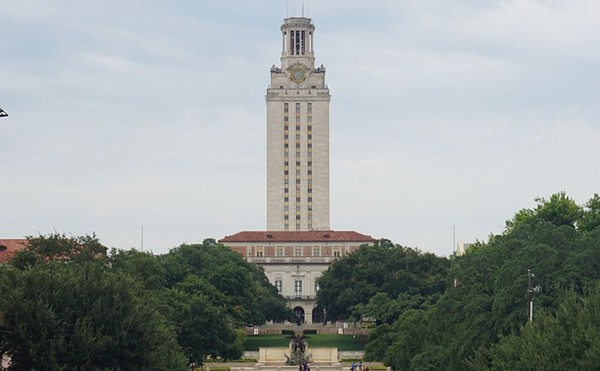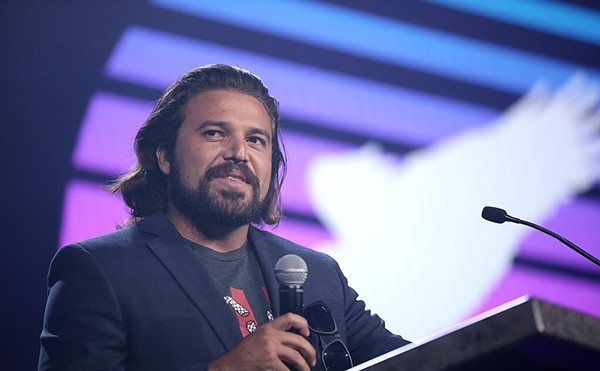| San Antonio Mayor Ed Garza is seen next to a reflection of Toyota Motor Corp. honorary chairman Shoichiro Toyoda - the son of Toyota's founder. Both men were featured speakers during the groundbreaking ceremony in south Bexar County for the Japanese automaker's newest plant. (Photo by Mark Greenberg) |
Visions of a gilded future entranced San Antonians in the fall of 2002. News that the city was in the hunt to land an $800 million Toyota plant sparked a gold-rush set of speculations about its potential boost to a sagging economy, its presumed impact on a tepid job market, and its projected cultural reverberations. With state tax revenues estimated at $20 million, and a projected 2,000 workers constructing upwards of 150,000 Toyota Tundra trucks, many felt that this proposed facility, in combination with its suppliers, would single-handedly rewrite the city's economic history, introducing industrial work to a post-World War II service economy. Were San Antonio to beat its competitors, it would find itself on uncharted terrain; to go forward, we would have to detour back in time.
The metaphorical U-turn became official in February 2003 - and again at last week's groundbreaking ceremony, which featured people ringing cowbells. Last winter, Fujio Cho, CEO of Toyota Motor Corporation, flew into town to headline a raucous celebration. A well-heeled and well-connected throng of 1,000 jammed into the balloon-filled Institute of Texan Cultures. Smiling broadly, the governor and lieutenant governor of Texas, members of the city's congressional delegation, and a host of local and state power brokers (many of whom also attended the groundbreaking) cheered, whistled, and stomped as speakers extolled the city's $130 million incentive plan and the state's largesse - it chipped in $15 million to build a new rail line to the plant, among other goodies. But the loudest roar was reserved for the new day that Cho promised for the community. "Besides being a great place to live and work, San Antonio is a city of the future," said Cho, at which point a thunderous ovation broke into his speech. The city's geographical location, which once had retarded its economic development, was now heralded as an asset. South Texas, Cho said, lies the middle of an important corridor for North American trade that "will undoubtedly serve as a vital link tomorrow for business all over the world."
We have heard such grand claims before. Thirty-five years ago, civic leaders were convinced that the site where the Toyota extravaganza occurred would also spark an economic miracle for the region. The ignition would be provided by HemisFair '68, which was to be San Antonio's bid for greater international prominence; its promoters had argued that this South Texas city was slated for great things because it stood at the "Confluence of Civilizations of the Americas."
Thirty nations, including Japan, set up shop in HemisFair Park for the six-month run. The fair opened April 6, 1968, and more than 6 million visitors toured the 92-acre site filled with national and state pavilions, art and cultural exhibits, and the usual midway fare. Yet, the event was a financial disaster. When it closed in October, HemisFair '68 had lost an estimated $17 million.
Despite the glaring deficit, the exposition had impacted the city's central core. HemisFair prompted the construction of the first new downtown hotels since the early 20th century, paving the way for subsequent development along the River Walk's landscaped paths. New restaurants flourished, too. With HemisFair '68, tourism had come of age.
The event's social significance was less profound. Although many of its planners had been integral to the voluntary desegregation of the city's restaurants in the early 1960s, their efforts, the NAACP charged at the time, were not enough. In general, African Americans worried that the fair would deflect the city's attention from resolving enduring inequities. Some of the more obvious forms of discrimination disappeared by the end of the 1960s, including segregation of parks, schools, restaurants, and public transportation. African Americans have also secured a seat at the political table: Since the mid-1970s, when a federal lawsuit forced a charter reform that required the creation of single-member districts, the predominantly African-American District 2, on the East Side, has always had an African-American representative.
For all these successes, inequalities remain unaltered by the post-HemisFair tourist boom. East Side schools tend to underperform, work opportunities are scarce, and the buildings have been neglected. This situation troubled the Reverend Claude Black, a legendary East Side African-American community leader and a former City Council member. Convinced that the post-fair "wave of prosperity has never been felt by the majority of black people," he concluded in the spring of 2003 that the East Side was "in worse shape than it was 35 years ago."
Yet even if the "idea of HemisFair putting us on the map is kind of overblown," in the words of local historian T.R. Fehrenbach, it altered the communal mindset. HemisFair, he said, laid "the groundwork for San Antonio to modernize." In the decades before the fair, nearly every attempt to industrialize the regional economy had encountered sharp opposition from the power elite. Fearful that industrialization would lead to unionized labor and escalating wages, unleashing a social revolution they could not control, the Chamber of Commerce, elite entrepreneurs, and politicians spurned opportunities to diversify and strengthen San Antonio's commercial prospects.
That is no longer the case. And perhaps that's why the organizers of the February 2003 Toyota celebration picked the Institute of Texan Cultures to host the mega-welcoming party. There was no better place from which to signal to the community that it was poised to enter a new stage in its economic development, from the tourist economy HemisFair '68 had fostered.
Yet, predicting San Antonio's future is tricky. No sooner had the confetti been swept up off the Institute's floor, and the multi-colored balloons pulled down from the ceiling, then bad economic news rolled in: More than 1,100 workers, many of whom earned upwards of $70,000 a year, were laid off at the Philips and Sony semi-conductor plants. Like other communities around the world in the mid-'80s, San Antonio had pursued this industry in quest of economic diversification and income generation, with hopes of capitalizing on, if not replicating, Austin's phenomenal investment in computer research and development. When VSLI (later Philips) set up a 330,000 square-foot plant in 1988, followed two years later by Sony's 550,000 square-foot site, it appeared that these dreams were coming to fruition - until the computer industry went into a freefall in the late 1990s, chip orders plummeted, and plants shuttered. This was not the first time that San Antonio discovered that global market corrections can have deep and dire local consequences. Nor will it be the last. •

